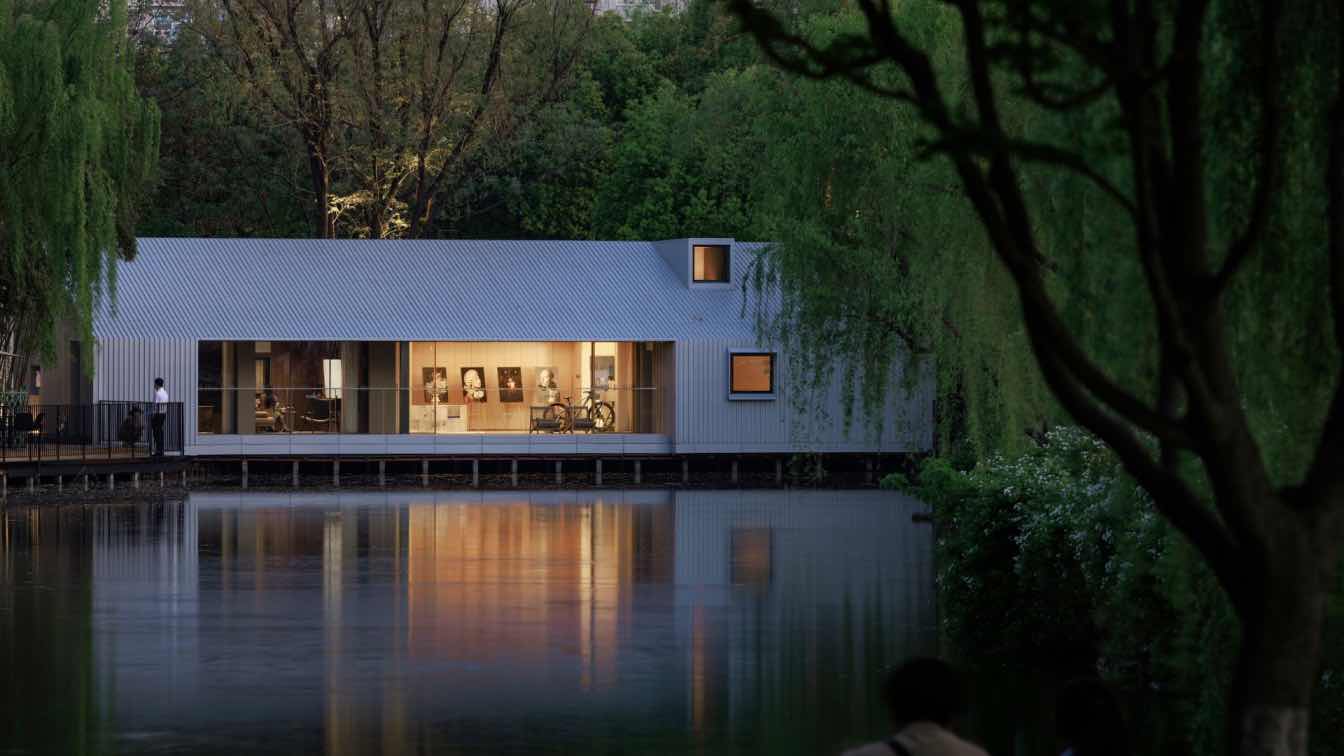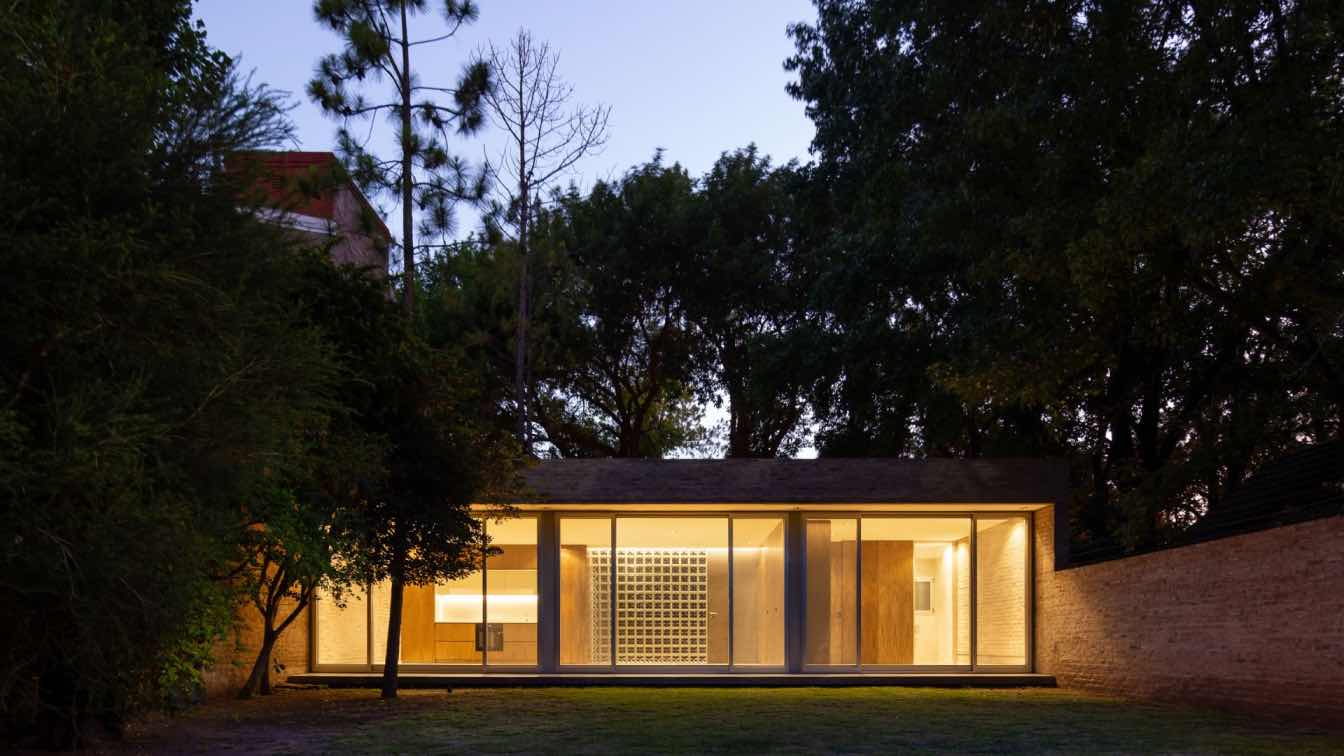A Glimmer of Light in Enchanting Green
The Lake House – Life Experience Pavilion
On April 18, 2025, The Lake House – Life Experience Pavilion, designed by Wutopia Lab at the commission of CSCEC Jiuhe East China Region, officially opened in Daning Park, Shanghai.
Part I: Working Diary
On February 28, Chief architect YU Ting was invited to survey three potential sites in the park and select one for the new pavilion. Representatives from the client’s design, engineering, and marketing departments, the construction company, and the park authority were all asked to join the visit. The park was to clarify the redline boundary, construction restrictions, and time limitations. The design department was to assign point persons for architecture, structure, and interior coordination. Engineering and construction teams needed to assess the site conditions, define the material supply chain and structural methods feasible within 40 days, and the marketing team was to provide usage programs, circulation plans, and curatorial requirements.
Based on all this, YU proposed a comprehensive design—architecture, interior, landscape, soft furnishing, and exhibition—aimed at achieving completion and public opening by April 18.
The final site chosen was the former water base by the bay. The only restriction from the park was to preserve the structures of two existing buildings and not disturb even a millimeter of surrounding greenery, including two trees abutting the façades. Meanwhile, the client hoped to incorporate ceramic curtain wall panels previously used in residential developments.
That same evening, YU applied his signature “house within a house” design strategy: two buildings were respectively wrapped in a metal and a ceramic skin. In a video call with structural consultant MIAO Binhai, they confirmed the feasibility: the metal shell would act as the climate boundary, while the ceramic skin would serve purely as a visual layer. The existing structure would retain its insulation and waterproofing.
YU passed his sketches and notes to project architect Liran SUN.
By March 5, the concept proposal was approved.
On March 12, YU, SUN, and HUANG He held a coordination meeting at CSCEC Jiuhe East China Region office with the full team, including construction partners. Every detail—from construction nodes to material delivery timelines—was confirmed, and a modular system was finalized. All trades were instructed to develop around this module.
This implemented Wutopia Lab’s core fast-build design strategy:
1. Pre-decided Standard Materials – No custom molds required.
2. Optimized Workflow – Maximize prefabrication, minimize wet work on site.
3. Integrated Systems – Consolidate architecture, structure, interiors, lighting, signage, curation, etc., in the design phase, locking key materials and detailing early.
This dramatically shortened the construction cycle and served as a replicable template for rapid-build architecture.
On March 13, MIAO Binhai and engineering head Mr. ZHU visited the site. MIAO proposed downsizing beams and columns to 150×150 mm steel profiles. These were integrated with the façade system, allowing the envelope and structure to become one. The combined system incorporated aluminum panels, vertical greenery, sliding glass partitions, light steel studs, and ceramic panels—achieving both formal unity and material coherence. The foundation, particularly on the waterfront and the lower southwest corner, used cantilevered bases to create a raised platform, facilitating rapid assembly.
In a follow-up call, YU and ZHU decided to replace aluminum-magnesium-manganese panels with more waterproof aluminum plates. Decorative aluminum trims (20×20 mm) were set at 100 mm intervals.
With that, the 190-square-meter Life Experience Pavilion entered full-speed construction.
March 20: Signage system completed
March 21: All construction drawings issued; exhibition and furnishing design initiated
April 11: Final site review by YU
April 14: Main structure completed
April 16: Soft furnishings, exhibition, and signage installed
April 18: The Lake House officially opened
Part II: Concept
In an interview, I said that Chinese people have a persistent attachment to nature—even when surrounded by concrete and steel. This sensibility makes us treasure even those things others discard. That’s why this pavilion uses ceramic panels, recycled tiles, marine plastic plaster, marine plastic panels, mushroom leather, and light to form an undercurrent—a zero-carbon narrative that lies beyond light and space. It reflects a core cultural belief: to cherish. From this, we move toward zero-carbon living and a beautiful life.
On February 28, standing on the bridge and seeing the site, Wright and Mies reawakened in my mind. It was the horizontal line—like a Chinese scroll unrolling. In our aesthetic tradition, a beautiful life is framed through landscapes, gently unfolding across the horizon. Even when the scroll ends, the scene continues in our imagination.
Using horizontal layers of light and shadow, I organized the preserved trees, vertical greenery, lobby, exhibition hall, three uniquely themed VIP rooms, willow-lined colonnade, terrace, boardwalk, and café into a linear spatial journey—inhabitable, walkable. The boundaries between inside and out dissolve. Orientation is gently disoriented, not in fear, but in delight. In these fleeting, sacred moments, one suddenly feels the emotional clarity of Chinese culture revealed in the everyday.
In VIP Room 1, you can sit and gaze at a window that becomes a living painting. The skylight above disperses quietly across you and me. Words fail.
I originally wanted a staircase under the skylight as a lookout, but the park didn’t allow it. We kept the skylight anyway. It now recalls old Shanghai tiger windows, or contrasts with the nearby tree hole as positive and negative space. It was not part of the original design—just improvisation. And isn’t that the charm of Chinese design? Controlled surprise within a plan.
On opening day, a passing elderly man reached out and gently touched the pearlescent ceramic wall. He stood for a long while, then smiled and walked away. That moment—was beautiful.
Epilogue: Space is Spirit
We once believed that material wealth defined a good life. Now, we realize a smile, a restrained surprise, or a moment of clarity on a sunny afternoon is the real beauty.
In that instant, architecture is no longer form or narrative—but spatial drama. In a place that can host “peaceful ambition,” we experience a brief sacred moment. And in that moment, life reveals its truth.
Architecture exists to capture that moment of beauty.
At Wutopia Lab, we live for that moment—fleeting yet timeless.
Space is Spirit.








